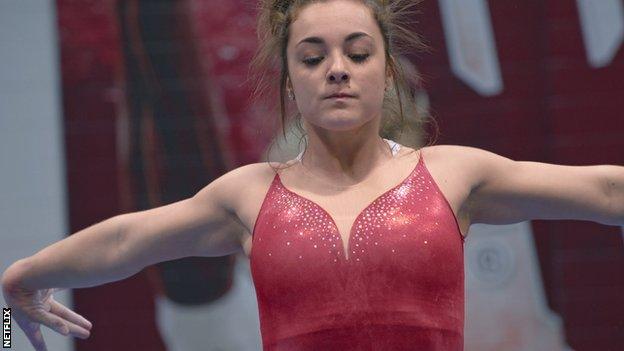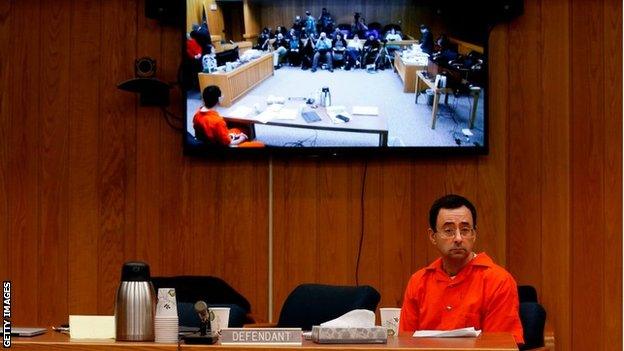Athlete A: Questions on Larry Nassar scandal explored in Netflix documentary
- Published

Maggie Nichols, who came forward initially as 'Athlete A'
What did it take to bring down Dr Larry Nassar - the USA Gymnastics team doctor who abused hundreds of young women?
Why did the abuse continue for more than two decades?
And did USA Gymnastics (USAG) cover it up?
These are some of the questions explored in Athlete A, a new documentary out on Netflix.
BBC Sport spoke to directors Bonni Cohen and Jon Shenk, as well as Rachael Denhollander - the first woman to publicly accuse Nassar and a key contributor to the film.

Further reading about the Nassar case

What's the story?
Nassar, a former USAG team doctor, was sentenced to more than 300 years for molesting young gymnasts in 2018.
An investigation by the Indianapolis Star, which began in 2016 with help from survivors, police and attorneys, brought Nassar to justice.
But the documentary reveals Nassar was never the main target for the newspaper.
"When we started to work with the IndyStar, we started to realise the investigation that led them to Nassar was actually an investigation into USA Gymnastics policy, around how it dealt with reports of sexual abuse," Shenk tells BBC Sport.
Cohen adds: "Larry Nassar was just one bad guy within a system that has tolerated abuse for decades. The truth that was exposed was that they had been burying cases for many, many years."
In a filmed deposition shown in the documentary, former USAG president Steve Penny admits the organisation did not always pass reports of assault straight to police.
Penny resigned from USAG in 2017 and was subsequently arrested for allegedly tampering with evidence in relation to Nassar. Penny refutes any suggestion of a cover-up and denies any wrongdoing.
USAG says it has shifted its organisation "to be more athlete-centric" with newly created athlete health and wellness roles, a new "safe sport" policy, and new educational initiatives.
How did the film come about?
Cohen and Shenk say the initial story came from former USA gymnast, Jennifer Sey, who was national champion in 1986 before retiring from the sport in 1988.
In 2008, she published a book called Chalked Up: Inside Elite Gymnastics' Merciless Coaching, Overzealous Parents, Eating Disorders, And Elusive Olympic Dreams.
"When the Larry Nassar news started to break a few years ago, she was very much in touch with the gymnasts at the centre of that story," says Shenk. "Ultimately, she got to know the journalists who were telling the story."
Shenk adds that access to the IndyStar investigation enabled them to start filming before Nassar went to trial. "As the number of survivors coming forward kept rising, we were able to document that," he says.

Jennifer Sey retired from gymnastics before the 1988 Olympics
Who are the key figures?
There are a lot of heroes in this film - journalists Marisa Kwiatkowski, Mark Alesia, Tim Evans and Steve Berta at the IndyStar; Detective Lieutenant Andrea Munford, who found child pornography images at Nassar's house; lawyers John Manly and Angela Povilaitis, who represented the survivors.
Of the survivors, there are three main focal points - former USA gymnasts Maggie Nichols, Denhollander and Jamie Dantzscher.
The titular "Athlete A" is Nichols, who reported Nassar to USAG in June 2015. Her family argue in the film that the claim was not dealt with properly.
"We were not going to go public, because we were told there was an FBI investigation and we could possibly jeopardise it," says Nichols' father, John.

Rachael Denhollander was the first woman to publicly accuse Nassar
Denhollander, who is now a lawyer, was the first woman to publicly accuse Nassar.
She was 15 when she went to see him for an appointment at Michigan State University. Over a year and a half, he repeatedly abused her, under the guise of treatment.
Some 16 years later, when Denhollander came across the IndyStar article alleging malpractice at USAG in 2016, she came forward to share her story. She had previously reported Nassar to a gym where she was working, but it was not taken further.
Alesia, a journalist at the IndyStar, explains how Denhollander turned up with about 100 pages of medical notes and a case prepared against Nassar.
At around the same time, Dantzscher also spoke to the paper, anonymously.
In response to these public statements, Nassar's lawyers denied he had ever touched a patient inappropriately during treatment. Hundreds of women, who knew that to be untrue, then came forward.

Jamie Dantzscher won team bronze at the 2000 Olympics in Sydney
Was there a culture of abuse in gymnastics?
In the documentary, Sey argues that emotional and physical abuse "was actually the norm" during her time as a gymnast.
Former USAG coaches Bela and Martha Karolyi, who came over from Communist Romania, where they coached 14-year-old Nadia Comaneci to a perfect score at the 1976 Olympics, are portrayed as having created a dangerous atmosphere.
"They brought with them the Eastern European methodology, which included not feeding the athletes very much and abusing them in various physical and psychological ways," Cohen tells BBC Sport.
She argues that laid way for "a way of thinking that would enable a predator like Nassar".
Bela and Martha Karolyi both deny the allegations and say they were never physically or verbally abusive.
Dantzscher describes how, at the time, Nassar seemed like "the only nice person" in gymnastics. She tells stories about him sneaking the girls candy at the Karolyi ranch, where the athletes trained monthly and where parents were not allowed access.
Why did Nassar come to light so late?

Larry Nassar has been sentenced to over 300 years in jail
When Denhollander took her story to the IndyStar, she also told Michigan State University Police, and she says she was not surprised to discover there had been multiple reports against him, from as far back as 1997.
"Larry was able to stay every time by simply saying: 'These women are confused'" Denhollander tells BBC Sport.
"It is a product of a community and a culture that sends the message that the sexual assault and abuse of women is not a big deal."
What is the key message of the documentary?
Shenk says: "Ultimately, it's a story about people who were taken advantage of by an organisation that lost sight of its responsibility."
He believes that those in power were guilty of neglect as gymnastics became more marketable.
"The Olympics is a big event in the United States. But, over the years, it became very much about the marketing of the athletes. Unfortunately, many of the organisations, including USA Gymnastics, did not have policies in place to protect the, often very young, athletes."
Are the directors happy with the film?
Shenk tells us there is some unfinished business.
'We still don't have a final settlement for many of the survivors who have filed suits against USA Gymnastics," he says.
Earlier this year, USAGproposed a settlement, externalthatit is reported, external would release Penny, the Karolyis and others from liability. That was criticised by American four-time Olympic champion Simone Biles and Denhollander, among others.
When asked what still needs to be done to mean justice has been done, Denhollander is unequivocal: "The answer is everything."